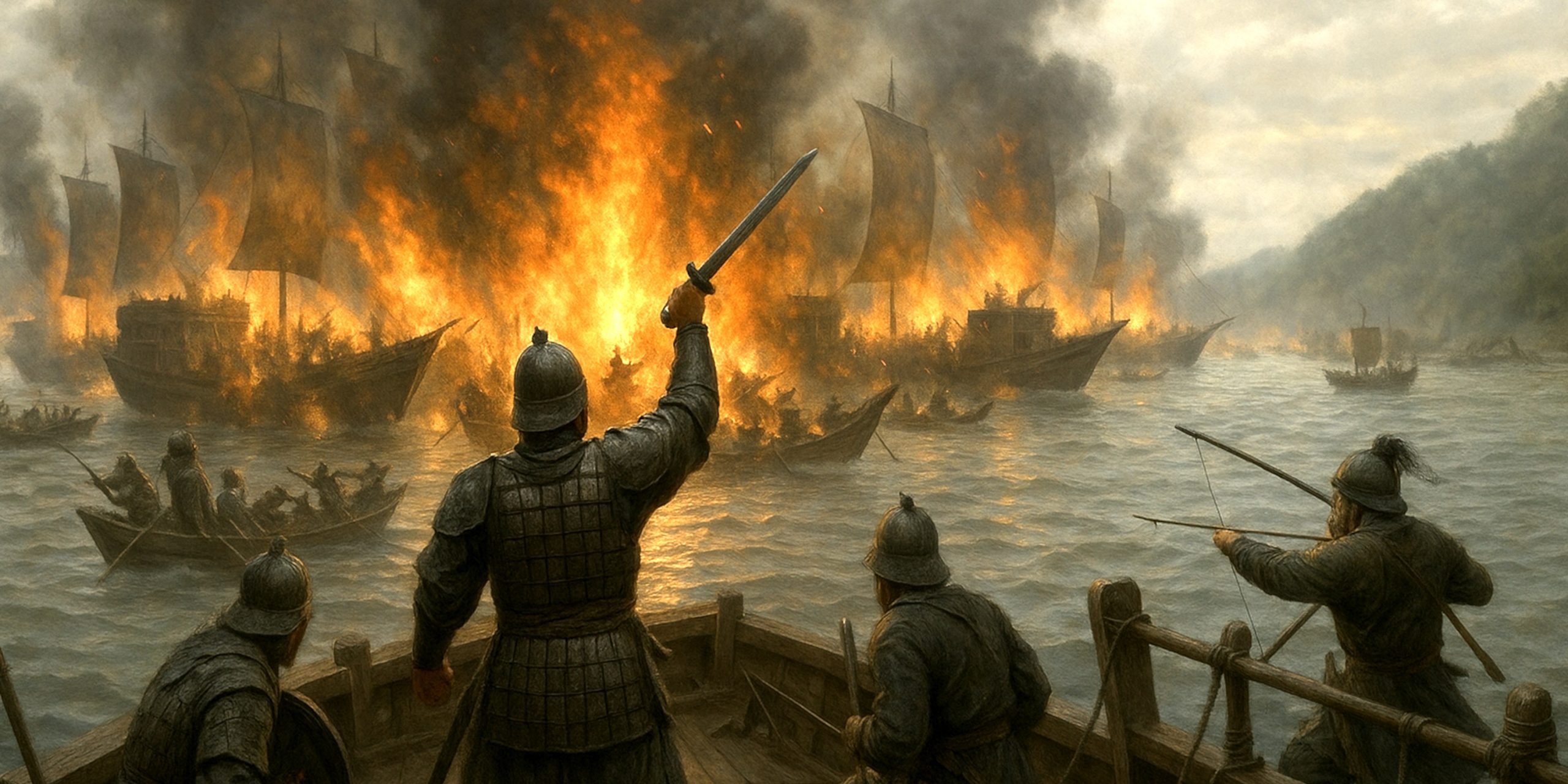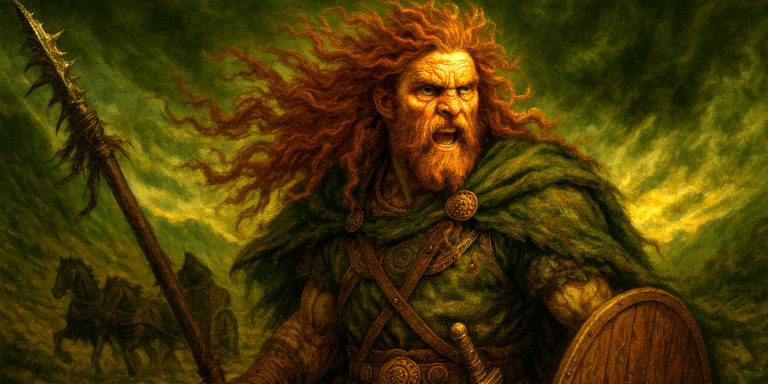
Red Cliffs sits at the heart of Chinese historical memory. It is the moment when Cao Cao’s sprawling northern coalition stalled, when the southern commanders Sun Quan and Liu Bei linked arms and decided they quite liked the idea of independence. The river became the great equaliser. Fire, wind and miscalculation did much of the heavy lifting, although the southern commanders were pleased to accept the credit.
I have never quite shaken the impression that this was less a single battle and more a slow collision of politics, personality and luck. Still, history prefers a clean label, so Red Cliffs it is.
Background
By 208 AD, Cao Cao had effective control of the north. His victory at Guandu had broken northern resistance and he now sought to extend his reach down the Yangtze. Sun Quan held the east and Liu Bei clung to survival in the west. Neither trusted the other entirely, but both trusted Cao Cao far less. That tends to sharpen minds.
Forces
The numbers are notoriously inflated in the sources. Even so, we can outline the broad shape of each side.
Coalition of Sun Quan and Liu Bei
| Category | Details |
|---|---|
| Estimated strength | 50,000 to 70,000 |
| Commanders | Zhou Yu, Cheng Pu, Lü Meng, Liu Bei (with Zhuge Liang advising) |
| Nature of force | Skilled naval troops, veteran riverine fighters, lighter infantry |
Cao Cao’s Northern Army
| Category | Details |
|---|---|
| Estimated strength | 200,000 to 250,000 (claims of 800,000 exist, but one must retain a sense of proportion) |
| Commanders | Cao Cao, with subordinates including Zhang Liao, Xu Huang and others |
| Nature of force | Primarily land based troops unused to southern climates and naval conditions |
Leaders and Troop Composition
The southern alliance had a smaller force yet a more coherent one.
Sun Quan and Liu Bei Coalition
- Zhou Yu, brilliant naval commander, fond of strong wine and even stronger decision making.
- Cheng Pu, veteran officer.
- Lü Meng, capable planner with a surprisingly scholarly streak.
- Liu Bei, charismatic but strategically inconsistent.
- Zhuge Liang, adviser, meteorological enthusiast if we trust later accounts.
Troop Types
- Veteran sailors
- Light infantry trained for fast manoeuvre
- Bowmen and crossbowmen
- Riverine shock troops armed with shields, spears and straight jian swords
Cao Cao’s Northern Army
- Cao Cao, master organiser, less impressive as a naval commander.
- Zhang Liao, aggressive and disciplined general.
- Xu Huang, dependable and relentless.
Troop Types
- Heavy northern infantry
- Cavalry dismounted due to terrain
- Pressed sailors unfamiliar with Yangtze navigation
- Troops weakened by disease and damp conditions
Arms and Armour
Southern Forces
| Weapon or Armour | Notes |
|---|---|
| Jian swords | Double edged straight blades, ideal for close quarters on narrow decks. |
| Dao swords | Single edged and curved, favoured by boarding parties. |
| Spears and short halberds | Vital for ship to ship fighting. |
| Lamellar armour | Lightweight and suitable for humid conditions. |
| Large shields | Used on deck to protect against arrows and incendiaries. |
Northern Forces
| Weapon or Armour | Notes |
|---|---|
| Jian and dao swords | Standard Han military issue. |
| Ji halberds | Good reach, less useful in cramped ship spaces. |
| Composite bows | Effective but sometimes hampered by damp climate. |
| Heavier lamellar armour and helmets | More suited to northern weather than the lakes of the Yangtze. |
The Battle
Cao Cao’s fleet was chained together for stability, a perfectly sensible idea until fire becomes involved. The south understood the river winds better and prepared a fire attack. Huang Gai, pretending to defect, approached with fire ships soaked in oil and kindling. The wind carried the flames directly into the northern fleet.
Chaos spread quickly. Ships burned, panicked soldiers jumped overboard and command structures dissolved. The southern fleet swept in, exploiting the inferno. Cao Cao retreated north along treacherous ground, losing many men to disease and exhaustion.
Battle Timeline
| Date or Stage | Event |
|---|---|
| Late 208 | Cao Cao moves south after capturing Jing Province. |
| Alliance forms | Sun Quan and Liu Bei combine forces under Zhou Yu’s operational command. |
| Initial skirmishes | Southern forces contest crossings and probe Cao Cao’s line. |
| Fire attack prepared | Huang Gai feigns surrender, loads fire ships. |
| Fire attack launched | Strong easterly wind pushes flames into Cao Cao’s chained fleet. |
| Northern army collapses | Retreat becomes chaotic as disease, fire and terrain take their toll. |
| Aftermath | South secures independence. Three Kingdoms era solidifies. |
Contemporary Quotes
The Romance of the Three Kingdoms is not a sober historical record, but it does preserve the drama Chinese culture associates with Red Cliffs.
- Zhou Yu, on seeing Zhuge Liang’s talent:
“Since Heaven gave birth to this man, why was I ever born at all”
One imagines this was said with clenched teeth rather than admiration. - Cao Cao, after the defeat:
“The empire is in chaos, yet heroes emerge on all sides.”
Chen Shou’s Records of the Three Kingdoms, far more restrained, simply notes the devastation caused by plague and unsuitable conditions in Cao Cao’s camp which, as a historian, I find refreshingly free of theatrics.
Archaeology
Physical evidence for Red Cliffs remains limited, although several sites along the Yangtze have produced items suggestive of Han era military activity. Finds include:
- Rusted lamellar plates
- Jian fragments recovered from river mud
- Arrowheads scattered near proposed landing sites
- Charred timber thought to be from burned ships, although confirmation remains tentative
Local museums along the Chibi region host exhibitions that mix archaeological finds with the far more exuberant folklore of the battle.
The Seven Swords Takeaway
Red Cliffs shaped the map of China for generations. Without it, Cao Cao may have unified the empire. Instead, the south proved it could resist and the Three Kingdoms era crystallised. Every later retelling grows more embellished, yet the core remains the same, a reminder that command of water, wind and logistics often matters more than sheer numbers.
It is a battle that betrays how fragile even the largest army can be if the environment turns against it. And it offers quiet satisfaction to those of us who enjoy seeing overconfidence punished by nature.
Watch the documentary:



